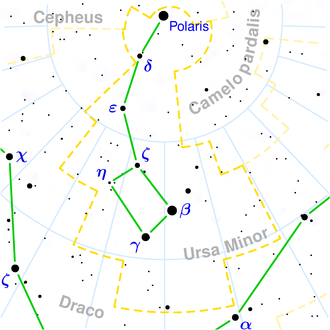NGC 6068
| Galaxy NGC 6068 |
|
|---|---|
|
|
|
| AladinLite | |
| Constellation | Little Bear |
|
Position equinox : J2000.0 , epoch : J2000.0 |
|
| Right ascension | 15 h 55 m 26.0 s |
| declination | + 78 ° 59 ′ 48 ″ |
| Appearance | |
| Morphological type | SBbc |
| Brightness (visual) | 12.4 mag |
| Brightness (B-band) | 13.2 mag |
| Angular expansion | 1.0 ′ × 0.7 ′ |
| Position angle | 155 ° |
| Surface brightness | 11.9 mag / arcmin² |
| Physical data | |
| Affiliation | isolated |
| Redshift | 0.013259 ± 0.000037 |
| Radial velocity | (3975 ± 11) km / s |
|
Stroke distance v rad / H 0 |
(186 ± 13) · 10 6 ly (56.9 ± 4) Mpc |
| history | |
| discovery | Wilhelm Herschel |
| Discovery date | December 6, 1801 |
| Catalog names | |
| NGC 6068 • UGC 10126 • PGC 56388 • CGCG 354-31 • MCG + 13-11-019 • IRAS 15575 + 7908 • GC 4163 • H III 973 • GALEX ASC J155526.06 + 785949.2 • KPG 476B • HOLM 727A | |
NGC 6068 is a 12.4 likes bright barred spiral galaxy of Hubble type SBBC in the constellation Ursa Minor at the northern sky . It is estimated to be 186 million light years from the Milky Way and about 50,000 light years across. Together with the non-NGC object PGC 56363 (also NGC 6068A ) it forms the isolated, gravitationally bound galaxy pair KPG 476 or Holm 727 .
The object was discovered on December 6, 1801 by Wilhelm Herschel with an 18.7-inch reflector telescope, who described it as “vF, S, lE in meridian, resolvable”.
